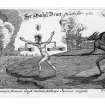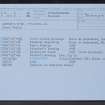Pricing Change
New pricing for orders of material from this site will come into place shortly. Charges for supply of digital images, digitisation on demand, prints and licensing will be altered.
Arthur's O'on, Stenhouse
Temple (Roman)
Site Name Arthur's O'on, Stenhouse
Classification Temple (Roman)
Canmore ID 46950
Site Number NS88SE 5
NGR NS 8793 8278
NGR Description Discovery area centred at NS c. 8793 8278
Datum OSGB36 - NGR
Permalink http://canmore.org.uk/site/46950
- Council Falkirk
- Parish Larbert
- Former Region Central
- Former District Falkirk
- Former County Stirlingshire
NS88SE 5 879 827
In c. 1720 W Stukeley together with Mr. Felf carried out a survey of sites along the Antonine Wall or 'Graham's Dike'. They especially looked at site of Arthur's O'on. The volume contains three fold out illustrations, the first shows Roman carvings and inscriptions from along the Antonine Wall, the second a plan and perspective drawing of the temple buildings and the third a map showing the length the wall and immediately surrounding areas.
Stukeley 1720 Bib No. 34379
(NS 8797 8273) Arthur's Oon (R) (Site of)
OS 6" map (1938)
Arthur's Oon was virtually complete until demolished in 1743, so for details we have to rely on early antiquaries (bibliography given in K A Steer (1958)).
It was built of dry freestone blocks measuring up to 4' by 1'10" with walls c. 4' thick describing a circle some 28' in outer diameter. Above, it rose in a corbelled dome to a height of 22' with a circular hole at the top which was perhaps original. A huge stone block inside, presumably the altar or statue base was reported by an early writer, and of the antiquaries who claimed to see carvings on the wall (mainly above the door inside), four made out eagles, two Victories, and two, inscriptions. The Oon's Roman date is certain as its masonry was far better than any native or Saxon work could be, and it is mentioned in a gloss on Nennius, perhaps of 9th century origin.
The building is unique. It was definitely a temple, since a bronze finger from the cult statue was found in a crevice (the figure might have stood on the pedestal mentioned), and was too far from a fort or road to have been a bath or mausoleum. Ox horns, perhaps sacrificial, were found nearby. Its proximity to a spring has caused the suggestion that it was dedicated to a water goddess, but the masonry is too good to suit a shrine to a local godling. Its skilful construction shows that only the military could have built it.
A broken relief from Rose Hill on Hadrian's Wall depicts Victory, an eagle, and a round domed building under a tree, which can only represent a structure like Arthur's Oon. If we accept the carvings alleged on the Oon, it is remarkable that they refer to Victory, and to eagles. It is true that Victory was normally worshipped in the forts, but the easiest interpretation is that the Oon was a tropaeum, an official monument dedicated to Victory, and also commemorating the campaign that led to the establishment of the Antonine Wall. Since the Oon is unlikely to be Agricolan, its dates are limited to the period of occupation of the Antonine Wall.
M J T Lewis 1965
When visited in 1950, nothing of the building was visible.
Visited by OS (FDC) 21 June 1950.
Field Visit (19 August 1958)
NS88SE 879 827
Roman Temple, "Arthur's O'on", Stenhouse (Site).
This remarkable building (Fig. 48, DP 266263), which survived until 1743, was situated on the N. side of the road from Carron to Stenhousemuir, opposite the N.W. corner of Carron Iron Works and just inside the grounds of Stenhouse (NS88SE 31). Its date and purpose have been the object of much speculation in the past, and the present account is a summary of a detailed study which has recently been published by one of the Commission's officers (1). The O'on was built of dressed freestone and in appearance was shaped like a beehive, being circular on plan with a domed roof: the internal diameter was 19 ft. 6 in. and the original height over 22 ft. The wall was about 4 ft. thick at the base but narrowed as it rose, and the dome was constructed of overlapping horizontal courses with their faces dressed to the proper curve. An opening in the centre of the vault, which measured 11ft. 6 in. across by the 18th century, was probably not an original feature, but may have been caused initially by a finial breaking off, and subsequently enlarged by the collapse or removal of some of the stones. The doorway, a round-arched opening measuring about 9 ft. in height and 5 ft. in width, was situated in the E. side, and immediately above it there was a nearly square window. Round the interior of the building there were two string-courses at distances of 4 ft. and 6 ft. respectively above the paved stone floor, and in several places, notably over the door, there may have been much weathered carvings in which eagles and the goddess Victory are said to have been represented.
Although the design of the dome has no precise parallels in Roman architecture, the identification of the O'on as a Roman temple or shrine can hardly be doubted in view of its isolated position 2 miles from the nearest Roman fort or road, the fact that it faced E. in accordance with ritual practice, and the discovery in a chink of the masonry of a brass finger which had presumably been torn from a cult statue. It may be thought, however, that a structure of this kind, which bears the unmistakable stamp of legionary workmanship, is too elaborate for a purely local or private sanctuary; and since it appears to have been deliberately sited to be visible from the Antonine Wall, it seems possible that the O'on was primarily a triumphal monument, or tropaeum, erected to commemorate a victory-and presumably the victory that was crowned by the construction of the new frontier line between the Forth and Clyde. Such at least is the traditional explanation recorded in a gloss in the Historia Brittonum (2), and it is worth recalling that on Hadrian's Wall a war-memorial was also apparently setup a short distance in advance of the barrier (3).
RCAHMS 1963, visited 19 August 1958.
(1) Arch. J., cxv, 99 ff.
(2) The passage runs as follows. Carutius postea imperator reedificavit et VII castellis munivit inter utraque ostia: domumque rotundam politis lapidibus super ripam fluminis Carun, quod a suo nomine nomen accepit, fornicem triumphalem in victoriae memoriam erigens construxit (see F. Lot. Nennius et l'Historia Brittonum (Paris, 1934) 165, note 5). The ascription of the monument to Carausius is not to be taken seriously.
(3) Arch. Ael., 4th series, xxi, 93-120.
Note (1978)
‘Arthur’s O’en, Stenhouse’ NS 880 827 NS88SE 5
Roman Temple; destroyed in 1743.
RCAHMS 1978
(Steer 1958, 99-101; RCAHMS 1963, p .118, No. 126; Brown 1974; Steer 1976)






























